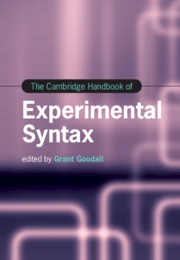Book contents
- The Cambridge Handbook of Experimental Syntax
- The Cambridge Handbook of Experimental Syntax
- Copyright page
- Contents
- Figures
- Tables
- Contributors
- Introduction
- Part I General Issues in Acceptability Experiments
- 1 Sentence Acceptability Experiments: What, How, and Why
- 2 Response Methods in Acceptability Experiments
- 3 Approaching Gradience in Acceptability with the Tools of Signal Detection Theory
- 4 Variation in Participants and Stimuli in Acceptability Experiments
- 5 Acceptability, Grammar, and Processing
- 6 Satiation
- 7 Acceptability (and Other) Experiments for Studying Comparative Syntax
- Part II Experimental Studies of Specific Phenomena
- Part III Experimental Studies of Specific Populations and Language Families
- Part IV Experimental Syntax beyond Acceptability
- Index
- References
4 - Variation in Participants and Stimuli in Acceptability Experiments
from Part I - General Issues in Acceptability Experiments
Published online by Cambridge University Press: 16 December 2021
- The Cambridge Handbook of Experimental Syntax
- The Cambridge Handbook of Experimental Syntax
- Copyright page
- Contents
- Figures
- Tables
- Contributors
- Introduction
- Part I General Issues in Acceptability Experiments
- 1 Sentence Acceptability Experiments: What, How, and Why
- 2 Response Methods in Acceptability Experiments
- 3 Approaching Gradience in Acceptability with the Tools of Signal Detection Theory
- 4 Variation in Participants and Stimuli in Acceptability Experiments
- 5 Acceptability, Grammar, and Processing
- 6 Satiation
- 7 Acceptability (and Other) Experiments for Studying Comparative Syntax
- Part II Experimental Studies of Specific Phenomena
- Part III Experimental Studies of Specific Populations and Language Families
- Part IV Experimental Syntax beyond Acceptability
- Index
- References
Summary
Judgments in acceptability judgment tasks are not uniform – because of the conditions involved, but also because of additional variation across participants and across items. Some of the variation is meaningful, some is noise. This chapter discusses both types of variation and provides recommendations on how to deal with them. We show how some of the interspeaker variation stems from micro-differences between grammars. Statistical procedures like distribution analysis or cluster analysis help in detecting such variation. The same procedures can be used to identify variation across items. Further, we outline how to reduce variation across and within items. In particular, we recommend keeping length and complexity of sentences constant as well as the accessibility of NP-antecedents. The rest of the chapter deals with variation stemming from extralinguistic sources. Beside individual differences related to performance factors, e.g. working memory, we discuss methodological artifacts like scale effects and non-cooperative behavior.
Keywords
- Type
- Chapter
- Information
- The Cambridge Handbook of Experimental Syntax , pp. 97 - 117Publisher: Cambridge University PressPrint publication year: 2021



